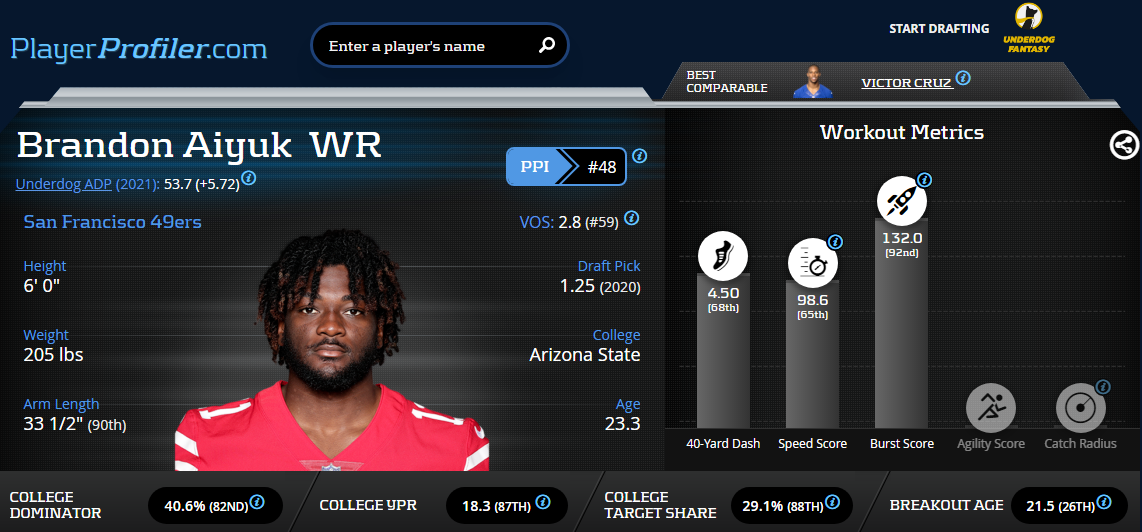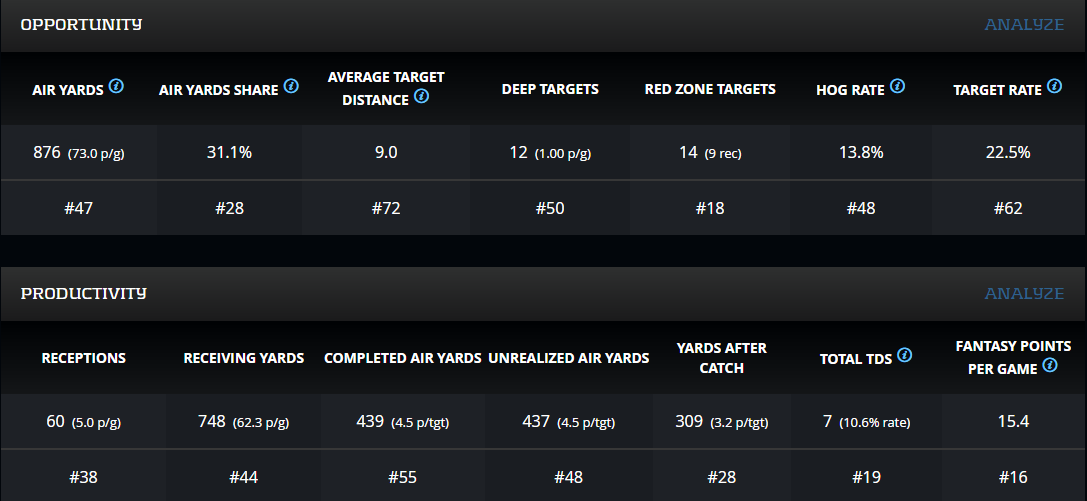The following contrived dichotomy (scheduled for one fall?) is to determine which player we should draft in our dynasty leagues; all else being equal.
Introducing first, in the RED CORNER: representing the San Francisco 49ers, standing 6-0 and weighing in at 205-pounds: BRANDON AIYUK.
His opponent, in the BLUE CORNER: representing the Cincinnati Bengals, standing 6-4 and weighing in at 216-pounds: TAMAURICE “TEE” HIGGINS.
The Tale of the Tape
This is a big one, folks!
In dynasty, it’s essential to identify young wide receivers on the cusp of a breakout season. Wide receivers provide stability and flexibility by maintaining their production for longer than running backs. They also have enough intra-positional variance for the highest scorers to provide a real advantage, unlike at quarterback. Accordingly, Brandon Aiyuk, age 23.3, and Tee Higgins, age 22.5, are two players who will make or break many teams.
Comparing these two is particularly interesting. They have similar ADPs. They had fantastic rookie seasons. And they belong to exciting, albeit nebulous offenses. However, they have key differences, and understanding these differences is crucial to successfully identifying the more valuable PPR dynasty asset.
Brandon Aiyuk
Brandon Aiyuk was taken No. 25 overall in last year’s draft and had an impressive rookie year, recording 60 (No. 38 among qualified wide receivers) receptions for 748 (No. 44) receiving yards and scoring seven (No. 19) total touchdowns in only 12 games. Extended to 16 games, and that’s 80 for 997 and seven.
Overall, Aiyuk flashed upside on a per game basis; however, his inconsistent playing time and injured teammates make it difficult to read too much into his stat line.
The Focal Point At a Young Age
Many of Brandon Aiyuk‘s peripherals suggest that what he did last year is repeatable. He had a 91.5-percent (No. 12) Snap Share, 23.2-percent (No. 23) Target Share, and 100.0-percent (No. 1) Route Participation rate, which are healthy metrics for a rookie. He’s also shown the ability to carry a passing attack in college, where he had a 29.1-percent (86th-percentile) College Target Share. All of this production as the focal point of an offense is encouraging. The ability to produce on large volume is what separates one from the pack.
It normally doesn’t make much sense to reference college metrics too much for established players. Still, Aiyuk is young enough to turn to them again here. He had a 40.6-percent (82nd-percentile) College Dominator Rating, which is correlated to repeatable yardage year over year and stronger breakout seasons. Commanding high draft capital, and the 49ers trading up for him, suggests they want to get him the ball.
The Upside
The best part about Brandon Aiyuk‘s profile is that he is a young and explosive piece in a Kyle Shanahan offense, greatly boosting his ceiling. Aiyuk is often used on short screens, jet sweeps, and other short trick plays because he is great in space. Last year, he showed off his 92nd-percentile Burst Score with 309 (No. 28) Yards After Catch. That said, his “poor” production metrics shouldn’t discourage us.
Aiyuk averaged 73.0 (No. 40) Air Yards Per Game, a 9.0 (No. 72) Average Target Distance, and only 12 (No. 50) Deep Targets, but boasted a much higher 31.1-percent (No. 28) Air Yards Share. These “depth-of-target” metrics are deflated because of short pass plays. And his comparatively strong Air Yards Share shows that he was still the focus of the offense.
Who’s the Quarterback?
The downside with Brandon Aiyuk is that the 49ers drafted Trey Lance with the No. 3 pick of the 2021 NFL Draft; a player who has question marks surrounding his passing ability. Even worse, Lance’s current skillset lies in his unique rushing talent, which will hinder his wide receivers’ production.
On the bright side, when Nick Mullens, Jimmy Garoppolo and C.J. Beathard targeted Aiyuk, they combined for a 72.2-percent (No. 83) Catchable Target Rate, 23 Uncatchable Targets out of 96 total targets, and 4.8 (No. 93) Target Quality Rating. This made his abysmal 61.9-percent (No. 76) Catch Rate and 85.7-percent (No. 51) True Catch Rate look much better. Still, Lance is far from a guaranteed improvement. And the quarterback situation in San Francisco isn’t exactly a boon to Aiyuk’s value.
The Takeaway
Brandon Aiyuk flashed high-end upside when he was on the field. He was elite on a per game basis, and his opportunity metrics legitimize that production. His athleticism, versatility, and belonging to a Kyle Shanahan offense all raise his floor and ceiling. However, there are unknowns surrounding him. Trey Lance‘s immaturity as a passer, and how Aiyuk performs alongside a healthy George Kittle and Deebo Samuel, will be what decides his value for the next five years.
Tee Higgins
Tee Higgins was taken with the first pick of the second round of the 2020 NFL draft and delivered 67 (No. 29) receptions for 908 (No. 26) receiving yards and six (No. 24) total touchdowns. While Brandon Aiyuk’s numbers, and especially his 16-game pace were impressive, Higgins’ production was real.
No need for any extrapolation; as far as rookie production goes, Higgins was fantastic. Whether he takes a step forward is going to depend on how many targets he receives relative to his teammates Tyler Boyd and Ja’Marr Chase.
And Higgins Overtakes Boyd!
Tee Higgins didn’t have an easy path to his productive rookie season. Joe Burrow, who was supposed to revitalize the Bengals offense, was injured. And Higgins had to overtake Tyler Boyd who is a capable receiver. However, Boyd doesn’t threaten Higgins’ future value. Despite being an established veteran with two 1,000-yard seasons, Higgins was already better than Boyd in key Opportunity (Air Yards, Deep Targets), Productivity (receiving yards), and Efficiency (Yards Per Reception) metrics. Assuming a normal career progression, Higgins will jump even farther ahead of Boyd in coming seasons. Our rankings bear this out.
Ja’Marr Chase, (Not) What the Doctor Ordered
Cincinnati’s biggest weakness on offense was their offensive line. Taking Penei Sewell out of Oregon with the No. 5 pick must’ve made a little too much sense since the Bengals instead drafted WR Ja’Marr Chase. With this level of draft capital, along with his monstrous profile and college production, Chase, unlike Tyler Boyd, threatens Higgins. Chase’s arrival in this offense has nearly single-handedly dropped Higgins’ value. He goes from a surefire top-six overall dynasty wide receiver to his current value.
There are several reasons I’m concerned about how Chase will affect Higgins. Firstly, Chase is an athletic freak. Secondly, he was dominant in college. He put up 84 catches, 1,780 receiving yards, and 20 touchdowns in a season, which was the 14th-most yards and 10th-most touchdowns in CFB history. Lastly, Joe Burrow reportedly campaigned for drafting Chase, which is concerning despite being a narrative-driven argument.
“A Guaranteed Superstar”
Corey Davis, Mike Williams, John Ross, Kevin White, Sammy Watkins, Tavon Austin, and Justin Blackmon. These are wide receivers drafted in the top-10 over the past ten years who never became stars (though Davis might still have a shot).
To be fair, players such as Amari Cooper, Mike Evans, Julio Jones and A.J. Green are the success stories who fit that criteria. But that still means 64-percent of wide receivers drafted in the top-10 in the past 10 years haven’t panned out. From what we know, Ja’Marr Chase will be different; however, these players show there’s still a chance he busts.
The Takeaway
Tee Higgins is a supremely talented, young, traditional wide receiver who is attached to a great quarterback. With a crowded receiver room, Higgins’ value will be defined by how many targets he receives relative to Tyler Boyd and Ja’Marr Chase. Signs suggest that Higgins has already overtaken Boyd in the pecking order, but Chase’s role is murky. While Chase might easily become the first option it is far from certain. Especially given that 64-percent of wide receivers drafted in the top-10 in the past ten years have busted. Regardless, at worst, Higgins will be the second option on a fantastic offense and be productive in that role. But he also has perennial top-12 upside.
The Go-Home
Tee Higgins has the better floor and ceiling, and his median projection is still similar to Brandon Aiyuk.
Higgins has a higher floor because he is, at worst, comfortably the second option with a far more established passer in Joe Burrow. In contrast, Aiyuk’s floor is the third option for a quarterback who is unable to develop as a passer.
At best, Higgins remains the first option and is a top dynasty asset for years. Aiyuk only reaches his ceiling if he becomes the second option behind George Kittle and Trey Lance matures as a passer over the next couple years a la Josh Allen.
https://www.youtube.com/watch?v=QSYVz0ho1Mc
Aiyuk reaching his ceiling depends on several external factors whereas the reverse is true for Higgins; he only reaches his floor if certain projections come true.
To reach his ceiling, Aiyuk needs either Lance or Jimmy Garoppolo to improve rapidly, and he must battle Deebo Samuel for touches while building off a productive, but small, sample of games. On the other hand, Higgins is already the first option on his team and will only hit his floor if Ja’Marr Chase can overtake him. Which is historically not a given, especially considering Higgins’ talent.












